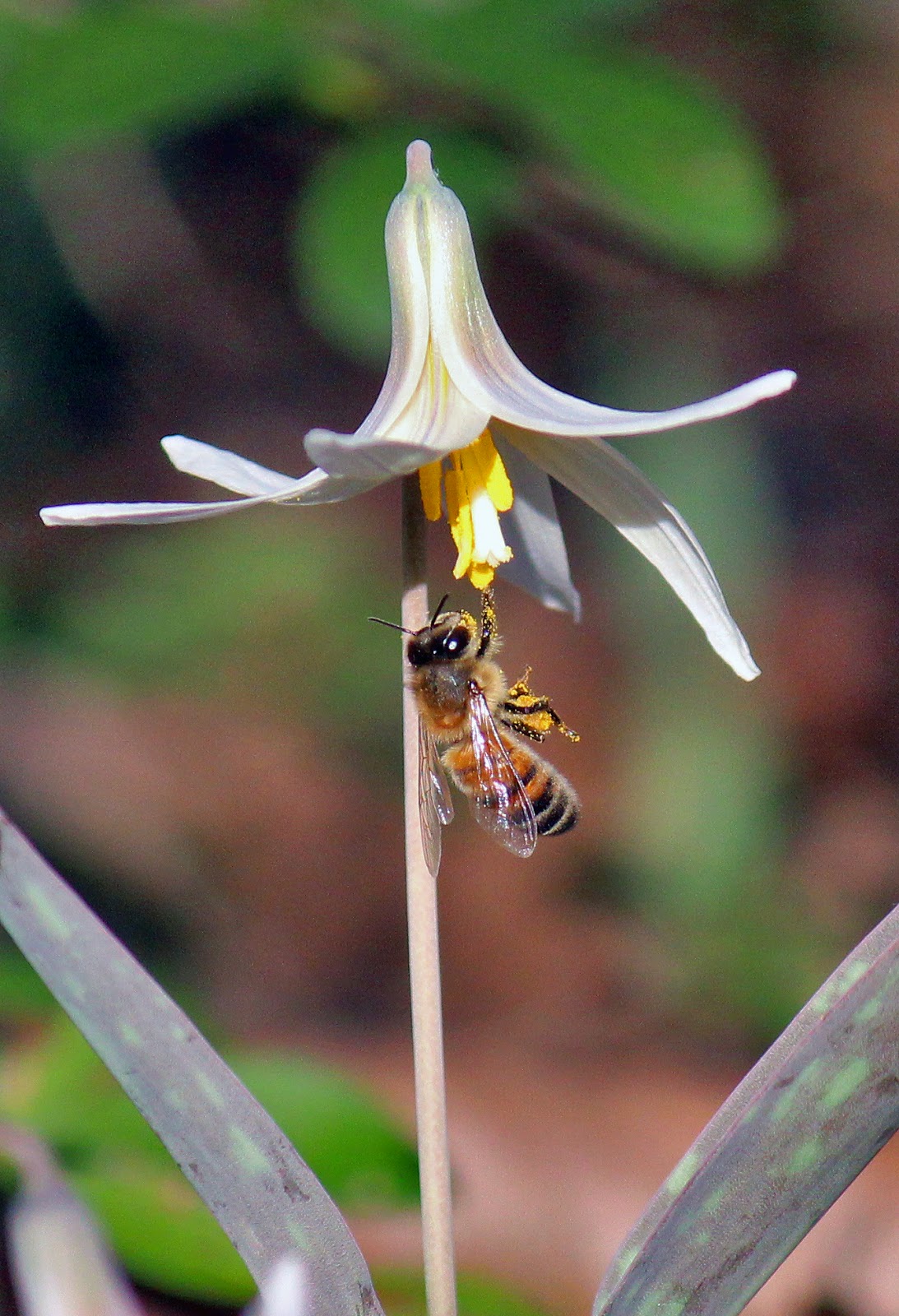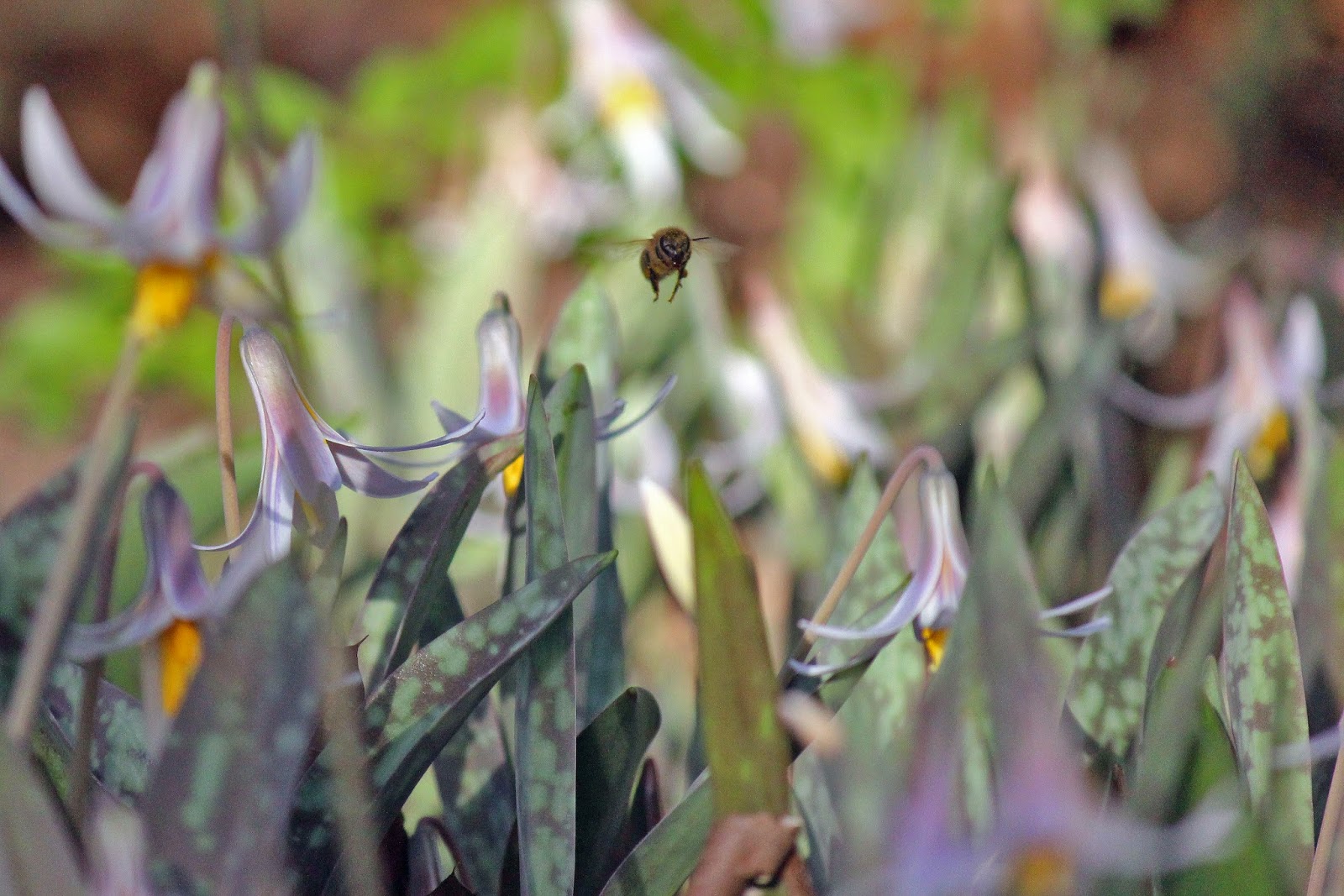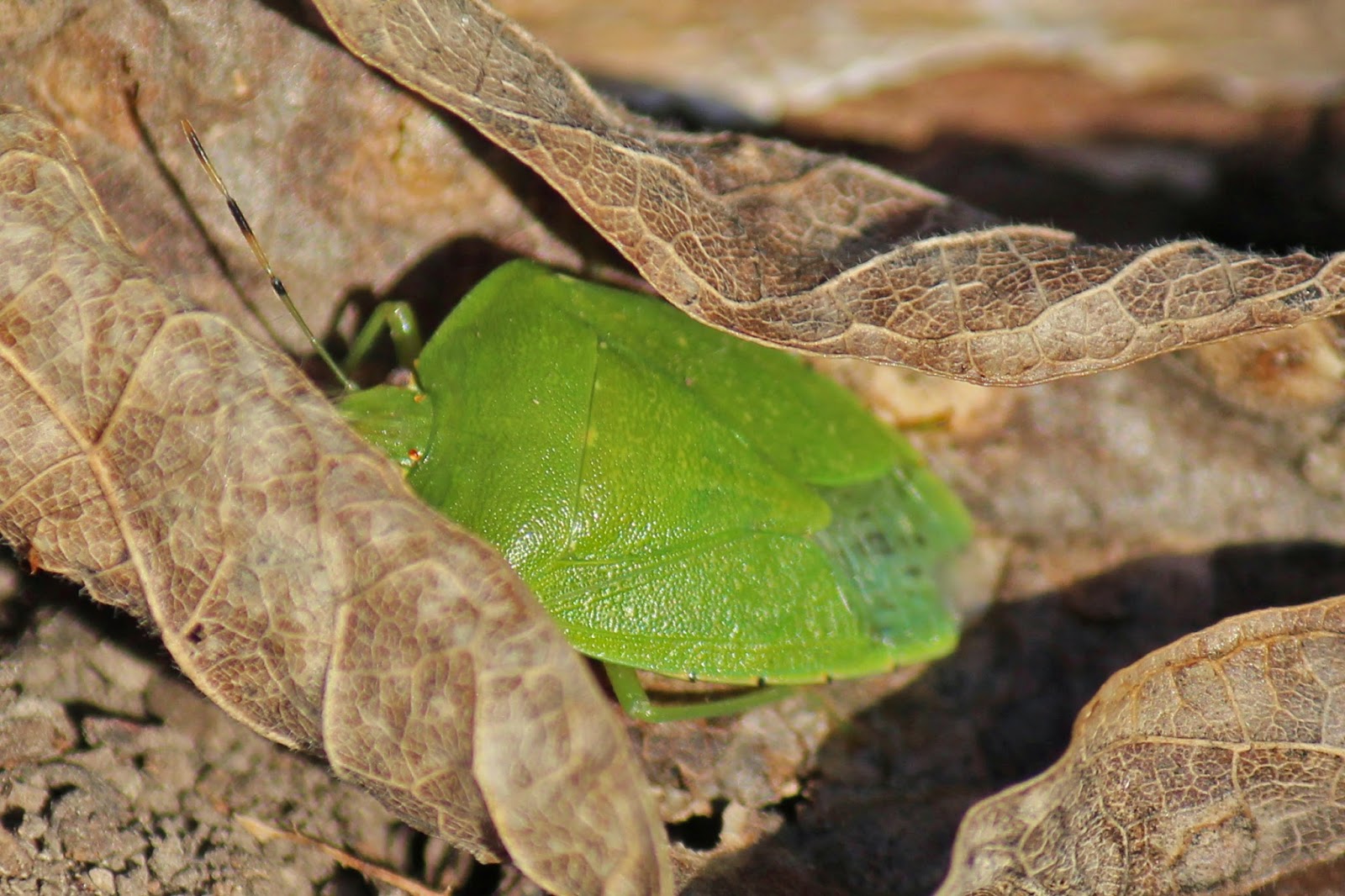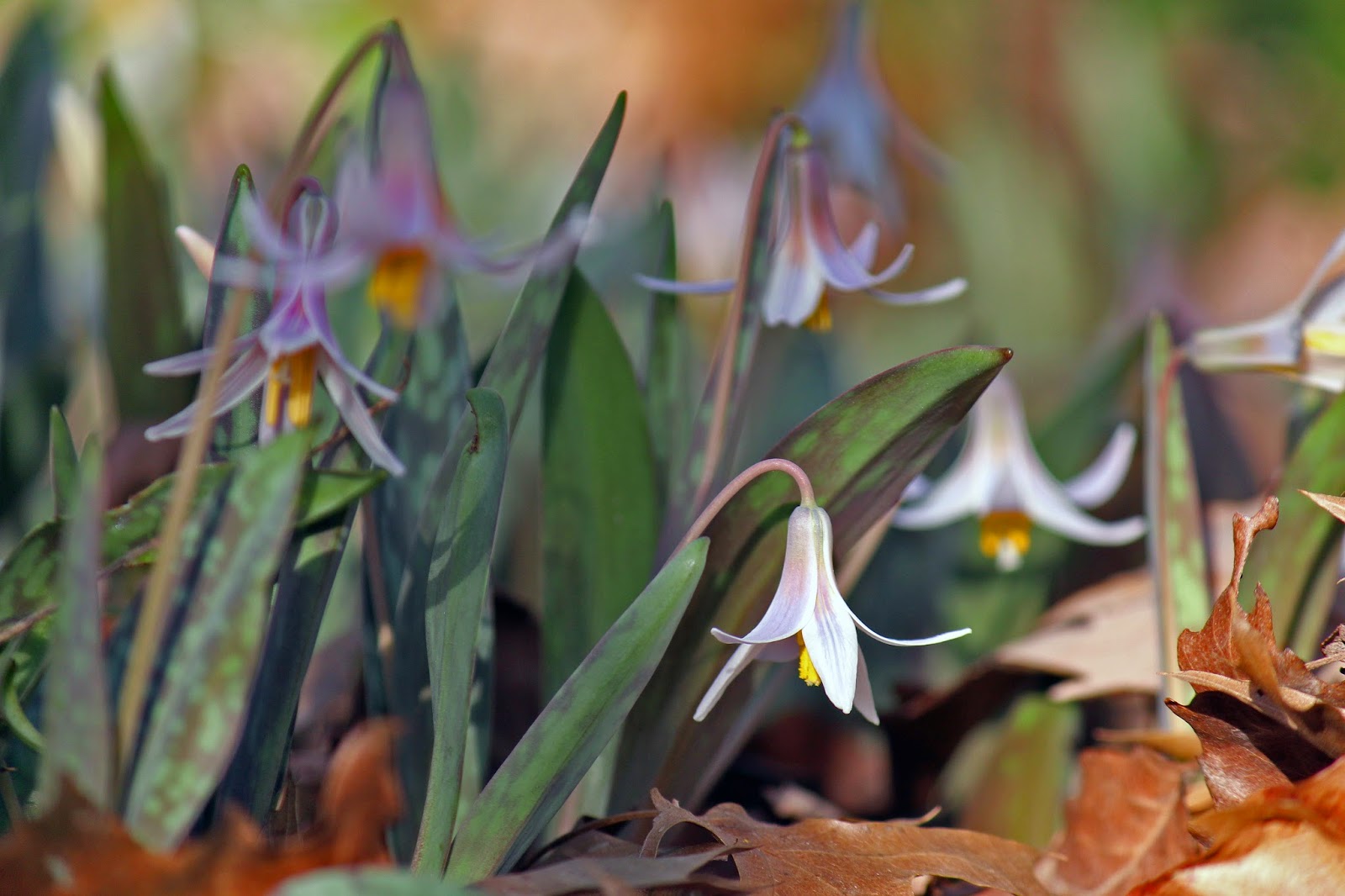Texas Trout Lilies Abuzz
 |
| A Trout Lily Erythronium albidum in full bloom, Dallas, Texas February 2014 |
The labors of spring begin anew in the smallest and most subtle of ways in North Texas. The dull and drab landscapes of the woods seem to be in a deep slumber in February. If you know where to look, in just the briefest of windows, one can spy a rare breed of flower few ever see. The leaf detrius and undercanopy of woods hides one of the more remarkable first flowers of the year, the Trout Lily.
 |
| Bee seen pollinating a Trout Lily, Dallas, Texas February 2014 |
 |
| Trout Lily plants just beginning to emerge |
It only sits above ground mere weeks and flowers only in the late afternoon and only sunny days for 3-4 days maximum. No sun, no open flowers. A real trick to spot them above ground, flowering, blooming in one of the wettest months on the Texas weather calendar.
The Trout Lily represents not just the first flowers of the new year. To many, the colonies of these plants represent very rare spots in Dallas where the land was never plowed, lumbered or disturbed in any way. Pollinated by flying insects like bees and seeds dispersed by ants, the Trout Lily is a very immobile species and rare as a result.
The Trout Lilies represented in the photos here were all taken in a few copses along drainages to the Trinity River basin and in places that would be damaged if too many knew about them. There are great public walks that are hosted around town where one can observe and learn about the unique flowering plant.
Where to see Trout Lilies
Post Oak Preserve in Seagoville
Spring Creek Forest Preserve in Garland
Dogwood Canyon Audubon Center in Cedar Hill
Cedar Ridge Preserve in Dallas
Upcoming guided Trout Lily walks
Feb 22 Spring Creek Forest (Garland) with Tom Frey 10:00 and 1:00
Feb 23 Cedar Ridge Preserve(Dallas) with Jim Varnum. 1:00
Mar 2 Tandy Hill Natural Area (Fort Worth) with Jim Varnum & Sam Kieschnick 1:00
These are worth attending, as you learn in about an hour what it would take you months to figure out on your own. In addition, the Trout Lily colonies can be hard to find if you don’t know where to look. Post Oak Preserve in Seagoville has the largest collection of Trout Lilies.
One of the tour guides, Jim Varnum, is actively searching for trout lily colonies in North Texas. People often tell me that things I personally find profoundly unique and rare, are very common in their own backyards. If you know of colonies growing in your neighborhood let him know as he is developing a database for the locations. He can be reached through his e-newsletter Jim’s This and That
The Trout Lily is an early spring arrival found blooming in the Trinity’s rich, moist woods. The six- to ten-inch tall plants are usually found in colonies, poking up through last autumn’s fallen leaves. Younger plants are flowerless and have only a single leaf, while older plants produce two leaves and a flower. Classified as a spring ephemeral, this plant disappears completely by the end of April.
The mature plants seen in the photos are at a minimum seven years old. From seed to first flower, it takes seven full growing seasons for a Trout Lily to produce a first flower.
There are estimated to be only 90 colonies of trout lilies remaining in Texas. No one is quite sure on their historical range prior to European settlement. There are great gaps in trout lily colonies in regards to geography. How widespread and how common they once were is a question yet to be answered.
 |
| Emerging trout lilies, some pushing fallen oak leaves skyward as they rise from deep underground |
The solitary flower of the Trout Lily nods toward the ground. This is believed to be a defense mechanism to keep certain insects away from the pollen and nectar.
The flower opens so completely during daylight hours that the three petals and three sepals are reflexed or curled backwards. The flower then closes again each evening.
 |
| Trout Lilies in the dabbled light of an early morning sunrise, flowers closed |
 |
| Trout Lily in full bloom Dallas, Texas |
The deeply buried bulb-like corm of this plant is shaped like a dog’s tooth, yielding another common name, dog-tooth violet. However, this plant is not a violet but a member of the lily family. Trout lilies grow in colonies most commonly created by offshoots from underground corms. These root structures resemble runners and can also be referred to as stolons.
The solitary flower above ground is pollinated by bees, and it may take as long as seven years for a germinated seed to grow into a mature plant.
 |
| Emerging trout lily through the fallen oak leaves of a forested floor in Dallas, Texas. Note the immature plants who lack flowers. |
Propagation of the Trout Lily
The flowering cycle for the Trout Lily begins and ends very quickly, only a few days at most. The flowers are usually closed in the morning and open by mid-afternoon. An eager visitor who searches for the blooms early in the morning will not be rewarded with open flowers. Better to wait late in the day or towards sunset to see them fully open.
The name trout lily derives from the distinctively mottled green and purple leaves that resemble a brook trout’s body. Another name, fawn lily, refers to the way the two leaves stand upright, like the ears of an alert fawn, and also the similarity of the leaves to the speckled coat of a fawn. Yet another name, adder’s tongue, may refer to the pointed shoots of the plant as it germinates in early spring.
 |
| Bee surveying the wide array of wild Trout Lily flowers in Dallas, Texas 2014 |
A Trout lily will reach a height of four to ten inches. Flower color can range from very pale white to bright white/purple and shows brownish streaks on the sepals, which may be lighter than the primary petals. In size it can be up to three inches across with six tepals (3 petals and 3 sepals) folding upwards. When the petals are fully reflexed, the bloom is approximately one inch across. Also known as Dogtooth violet (referring to the shape of the bulb), this plant is a member of the lily family (Liliaceae) and not a violet. Other common names include Adder’s tongue and Serpent’s Tongue given the emerging shape of the flower.
The Trout Lily is unique in more ways that one. The flower is pollinated by flying insects and sometimes wind (as are many lilies). It produces a seed capsule on the end of the stalk, which falls to the ground as the capsule matures and fades from green to white. The capsules are about the size and shape of a small chick pea, and contain 5-25 seeds, about a sixteenth of an inch in size.
The seeds are spread by ants, who eat a nutritious appendage attached to each seed and leave the rest to germinate, often at several feet distance form the original plants. Ants can carry the seeds some distance and will eat the husk at their antpile leaving the seed behind.
 |
| Bee heavily laden with pollen, climbs into the flower of a Trout Lily in Dallas, Texas |
The race from bulb to flower to seed completes in a ten weeks. Short by any measure. Shorter still is the actual flowering period that when given the length of time flowers are actually open, can be measure in hours. Rare and special to see. Trout lilies take so many years to mature, so difficult for seed to spread, so hard to see in other times of the year that they have become a splintered subset of colonies here in the Dallas area.
Separated by great distances in geography and existing in ecological isolation, Texas Woman’s University is conducting DNA sampling in the various colonies in Texas to determine their genetic structure. Scientists note there are two main threats to the trout lily colonies here in the Dallas area. Threat of habitat loss by humans and the spread of plants like invasive Garlic Mustard (Alliaria petiolata).
Perils of Privet
 |
| Heavily shaded trout lilies under a deep choking canopy of Chinese Privet |
Trout Lilies are quite fussy with where they live. Their arrival and blooming coincides to a time on the calendar about 3 weeks before oaks start leafing out. This is a time when the forest floor is warm and in full sun. Been this way for eons I suppose. Until the arrival of the dreaded Chinese Privet.
In the Great Trinity Forest, the invasive Chinese Privet is capable or choking out all beneath it. Visiting a few of these colonies most seem to be clear of encroaching invasive species, the exception
 |
| Green Stink Bug hiding in the leaves |
being some colonies in Dallas which are seeing detrimental impacts.
These throwback spots in the natural world are getting fewer by the year. Housing development and urbanization claimed many of the trout lily colonies in previous decades. The cherished and rare remaining colonies now suffer from invasive Chinese Privet. The lack of know-how, bitter squabbles with neighborhood politics and lack of resources to manage privet will surely lead to the extirpation of populations on the brink at parks like White Rock Lake. There are a very few there, fewer in number every year due to privet infestation.







